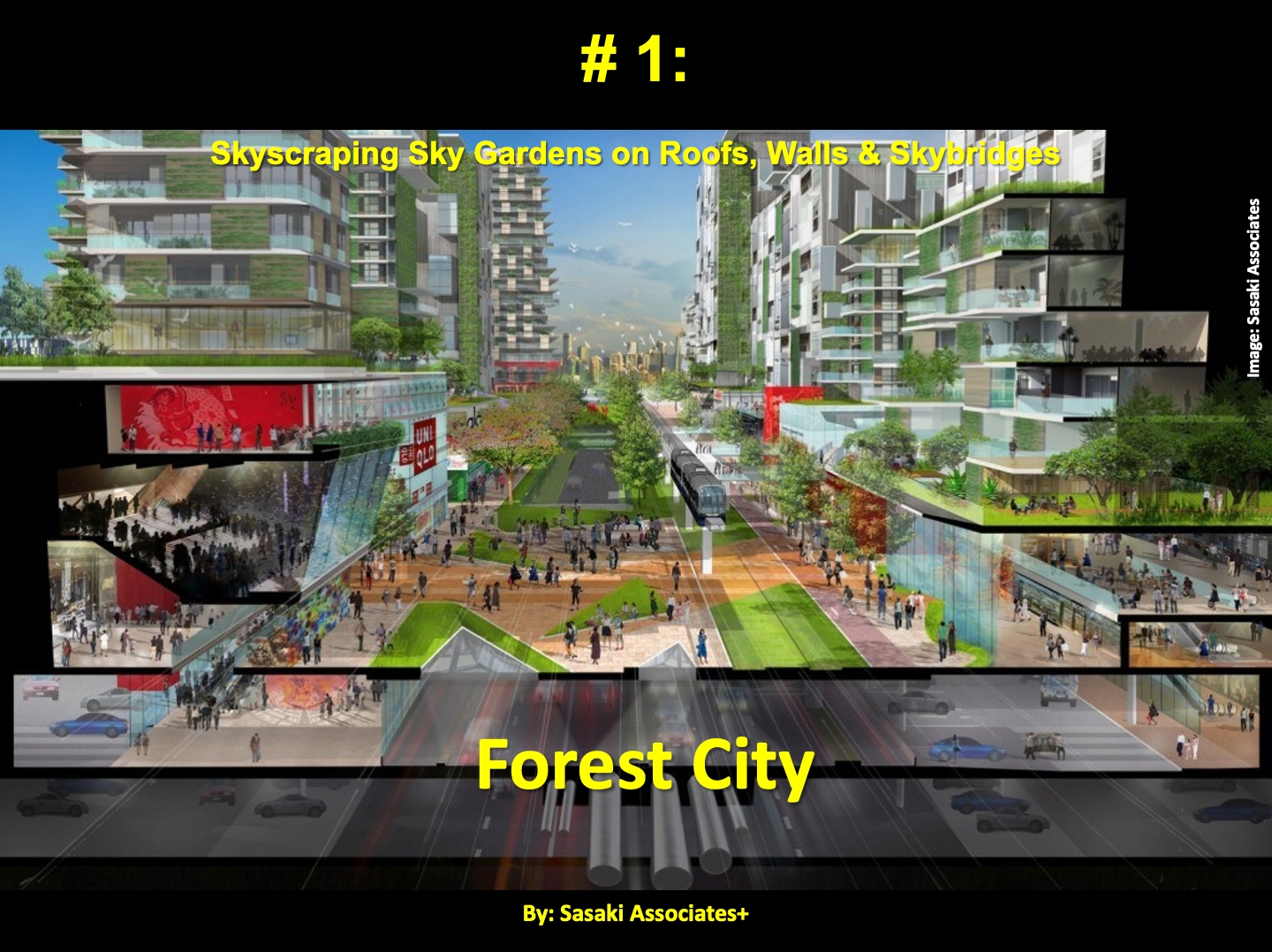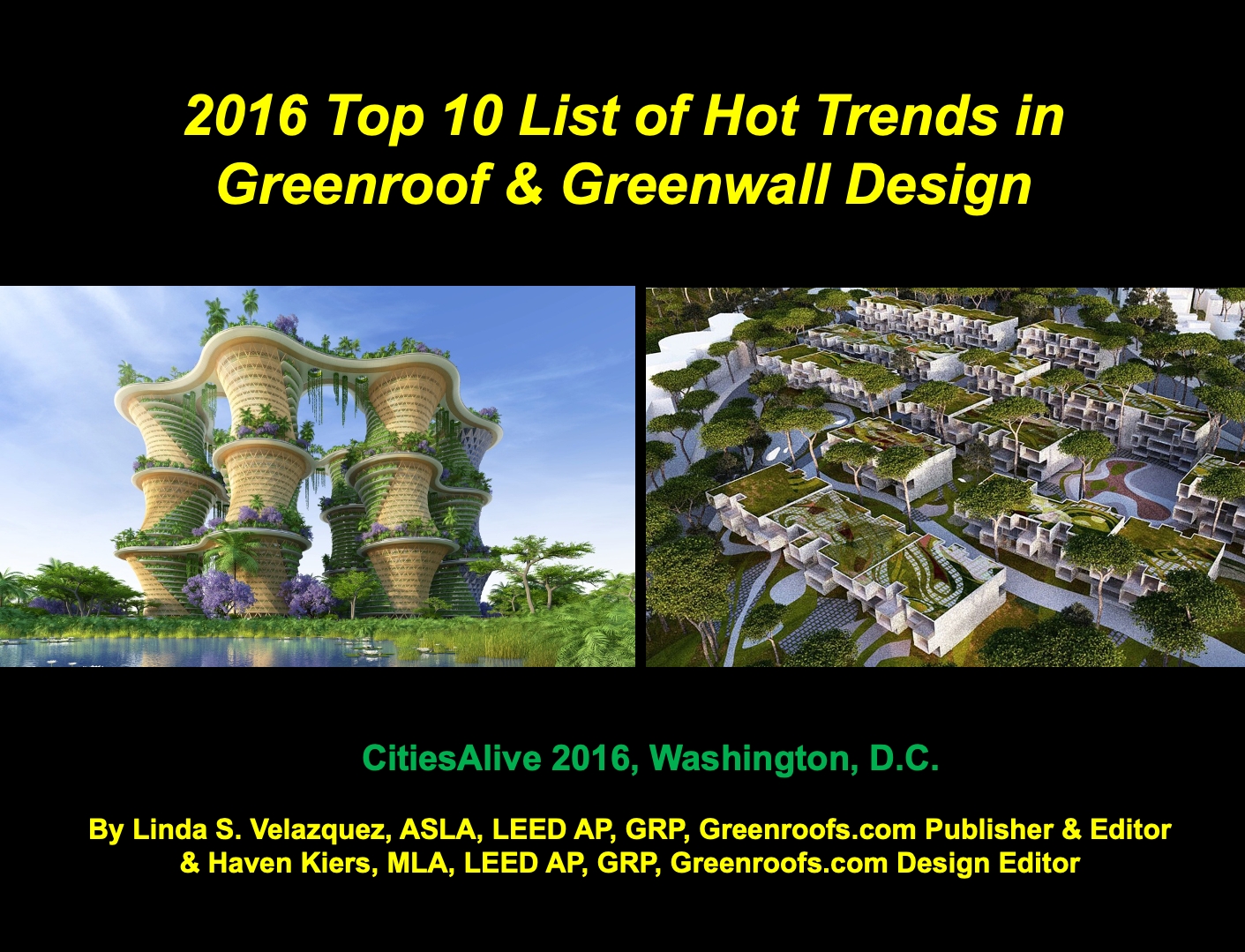It’s hard to believe 2016 is coming to a close! Here is our Greenroofs.com’s 2016 Top 10 List of Hot Trends in Greenroof & Greenwall Design for you vegetated building envelope lovers.
Now in our tenth year, for 2016 Greenroofs.com Design Editor Haven Kiers and I, as Publisher, compiled a special 10th Anniversary Edition of our popular “Top 10 List of Hot Trends in Greenroof & Greenwall Design” series with the theme of “What’s old (or classic) is new again!” We reviewed our trendsetting categories of yearly en vogue market drivers and architectural designs of the past decade and featured our favorite top 10 groupings we considered most timely and significant – yet revitalized with new and exciting projects and designers.
Our favorite green architecture designers are here including Emilio Ambasz, Bjarke Ingels Group (BIG), Vincent Callebaut, just to name a few. So here goes:

The Greenroofs.com “Top 10 List of Hot Trends in Greenroof & Greenwall Design”:
10) Client Specific ‘Boutique’ Greenroofs & Greenwalls
9) PreFab Modular Homes are Fabulous
8) Earth-Sheltering for Sustainable Site Design
7) Gardens in the Clouds: Stacking & Stepping with Vegetation
6) LID Strategies: Celebrating Water with Greenroofs, Rain Gardens, Stormwater Catchment & Beyond
5) Innovative Greenwalls: Stretching Design & Our Imagination
4) Educational Facilities as Green Living Laboratories
3) España: A Progressive Líder in Green Design
2) Sky Farms on the (High)Rise
1) Skyscraping Sky Gardens on Roofs, Walls & Skybridges
Always striving for a captivating combination of ecosensitivity and chic sustainability, 2016 once again featured some of the best and brightest designs as inspiration to us all. Some of the projects selected include:
10) Client Specific ‘Boutique’ Greenroofs & Greenwalls – a Greenroofs.com perennial favorite category, 2016 includes the Veneto Eye Bank Foundation (Fondazione Banca degli Occhi del Veneto Onlus) – giving metaphorical life to the blind in Venice-Mestre, Italy. The two extreme points of the trapezoidal 12m high walls seem about to touch each other, reminiscent of The Creation of Adam by Michelangelo. The entry to the eye transplant and stem cell research facility opens to stepped gardens and greenroof, and is surrounded and located over a large on structure greenroof over the parking garage. In Bogotá, Colombia, the “Seedkeeper” guards culture and biodiversity. The small Terracita Organica (Organic Terrace) embraces urban ag in heart of the city and ensures native plant survival. Run in secret and part of an underground movement, the rooftop seed reservoir preserves heritage and provides food security for Colombia: retrieving seeds, recovering knowledge, recovering memory.
9) PreFab Modular Homes are Fabulous – The “3box” system in Paris adds prefabricated elements on top of and between existing buildings. The low income housing system does not require the purchase of sites; instead, the right to build is obtained in exchange for renovating existing buildings. Tangier Bay in Morocco is a modular social housing project with adjustable greenroofed habitats. Buildings are equipped with loggias and terraces with several functions: provide beautiful views of the ocean, facilitate natural ventilation and allow natural lighting through.
8) Earth-Sheltering for Sustainable Site Design – The Great Wall of WA in northwest Australia is a serpentine structure encompassing 12 homes sharing a rammed earth façade. Rammed earth extracted from the local clay pans, pebbles and gravel quarried from the river bed are the palette of materials that blend into the landscape. The Wasit Nature Reserve outside of Sharjah, UAE, is a former waste-water and landfill site transformed into a visitor center. The earth-sheltered site is now home to 350 different bird species, as well as a landing zone for over 30,000 migrating birds.
7) Gardens in the Clouds: Stacking & Stepping with Vegetation – ‘489-539 King Street West’ is a current redevelopment scheme in Toronto and will be a staggered cubic ziggurat with verdant rooftop sky gardens. The 500 stepped apartments on top will cover the lower floors of mixed-use. The Marina One in Singapore is a current multi-use project with luxury condos. Stacking and stepping internally, its inner core forms a 3-D void dripping with vegetation. This ‘Green Heart’ is the largest public plaza in the CBD; and, the building footprint is penetrated by air wells and slots to ensure natural ventilation.
6) LID Strategies: Celebrating Water with Greenroofs, Rain Gardens, Stormwater Catchment & Beyond – The highly innovative blue-greenroof Cira Green at Cira Centre South is Philadelphia’s first elevated park which also aggressively manages stormwater 11 stories up. Placed below the greenroof paving, “Pancake Cisterns” are thin detention cisterns which capture rainfall and release it gradually to the adjacent planted areas via a system of Sutro weirs. The 2.9 acre site of the Center for Sustainable Landscape, part of Phipps Conservatory and Botanical Gardens in Pittsburgh, is Net Zero Water and Net Zero Energy. Designed with multiple LIDs, it’s the first and only building to meet 4 of the highest green certifications: Living Building Challenge, world’s most rigorous green building standard; LEED® Platinum — tied for highest points awarded under version 2.2; first and only Four Stars Sustainable SITES Initiative™ (SITES™) for landscapes project (pilot); and the first and only WELL Building Platinum project (pilot).
5) Innovative Greenwalls: Stretching Design & Our Imagination – The Global Change Institute is the University of Queensland’s landmark zero-carbon, six-star collaborative hub which generates more energy than it consumes. It has paneled greenwalls over the indoor air-conditioning vents designed to draw and expel air through the plants in order to maximize dust and VOC reduction giving a biological treatment to air in the building as well as providing amenity. Naman Retreat the Babylon in Ngu Hành Son, Da Nang, Vietnam, boasts a building façade combining concrete louvers with interspersed greenery and the wire-trellised green wall provides a visual barrier to enhance the privacy of the resort. The harmonious mix of greenery, natural stone and bamboo provide a perfect atmosphere that enable the guests a maximum body and mind purification and relaxation.
4) Educational Facilities as Green Living Laboratories – Completed this year, the National Health, Wellness and Learning Center at Community School 55 in the South Bronx is a School Garden to School Cafe Site by the Green Bronx Machine. Headed up by educator and administrator Stephen Ritz, a Global Teacher Prize Finalist who donated his $25,000 winnings to refurbish an area of the 100+ year old reclaimed school, it is NYC’s 1st elementary-workforce development school and training for residents. Facilities include indoor and outdoor gardens, robotics, a 100% mobile classroom kitchen with broadcast capabilities, solar and pedal power stations, and computer lab. In Barcelona, Spain, a series of vertical edible gardens designed and implemented by landscape artist Marc Grañén informs and creates an urban network of biological info vital for understanding natural biological rhythms of the city. He received support from the environmental department of the Barcelona City Council and School Agenda 21, with the collaboration of Obra Social La Caixa.
3) España: A Progressive Líder in Green Design –The new Joan Maragall Library in Barcelona preserves open space and gardens by moving them up to the roof, creating a new social hub. The architects decided to create a terrace and place the library program underneath, while the greenroofs now constitute the new garden known as the ‘Garden of Light.’ La Calahorra Green Wall in Elche addresses the challenge of combining a coffee shop within a vertical garden with the complexity of a structure attached to a historic building, built in the late twelfth and early thirteenth century. The addition of the robust living wall created a destination and new landmark with 3,000+ plants and 15 species of five different families, mostly endemic to the Mediterranean region.
2) Sky Farms on the (High)Rise – The Farming Kindergarten Dongnai in Vietnam has a continuous looped greenroof used as both a large, safe playground and as an agricultural area for the adjacent shoe factory workers’ children. It grow five types of vegetables planted in an experimental 200 m2 roof garden for agriculture education and also serves as a prototype of a sustainable, low-budget education space in a tropical climate. “HYPERIONS” in Jaypee, India are garden towers of agroecology and sustainable food systems growing up around 6-multi use wooden and timber-framed towers. Double objective of energy decentralization and food deindustrialization. The architect claims that converting worldwide agriculture into organic techniques and bio-sourced construction could reduce worldwide CO2 emissions by about 40% by 2030.
1) Skyscraping Sky Gardens on Roofs, Walls & Skybridges – The Mile is a conceptual design for the world’s highest vertical park and public observation deck at one mile (1,609 meters) offering a natural ecosystem, eventually covered with plants and greenery and inhabited by hundreds of animal species. The architect says “Imagine you take New York’s Central Park, turn it vertical, roll it and twirl it.” Adding to transformation of New York City’s skyline is The Spiral, is a 65-story office tower that is fully wrapped in a cascading ribbon of lushly planted terraces, hanging gardens and soaring atria. Its architect states “The Spiral will punctuate the northern end of the High Line, and the linear park will appear to carry through into the tower, forming an ascending ribbon of lively green spaces, extending the High Line to the skyline.” And finally, Forest City in Iskandar, Malaysia to be completed by 2036, is a $40.9 billion masterplan to be new global cluster of commerce and culture. Set to be south-east Asia’s largest mixed use green development and the world’s largest greenroof system, it will consist of a rooftop network of interconnected parks and gardens.
I presented the 2016 Top 10 List solo at this year’s Cities Alive Conference in Washington, D.C. since Haven couldn’t make it, and you can see the entire “Greenroofs.com 2016 Top 10 List of Hot Trends in Greenroof & Greenwall Design + a Look into 2017” video at our upcoming 2017 Greenroofs & Walls of the World™ Virtual Summit coming in April.
By Linda S. Velazquez, ASLA, LEED AP, GRP
Greenroofs.com Publisher
 Greenroofs.comConnecting the Planet + Living Architecture
Greenroofs.comConnecting the Planet + Living Architecture






Alkire Leanna
nice post thanks for sharing this information.
Maria Dones
Some of them are still trendy in 2018. Thanks for sharing will surely implement some of them.
Dimitri
Can you provide any information about sky farming ?
AxeTreePros Maryland
Amazing Information about Green-roof and Green wall Design
thank you for sharing such a useful blog
Regards
AxeTreePros
https://www.axetreepros.com
Artificial Turf Supply Canberra
Very nice post you have shared…thank you